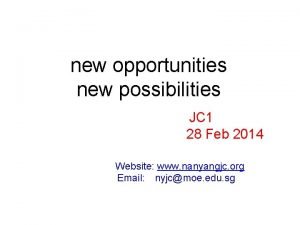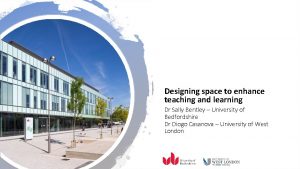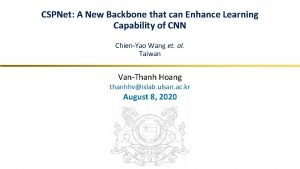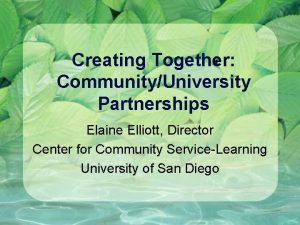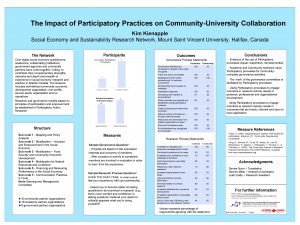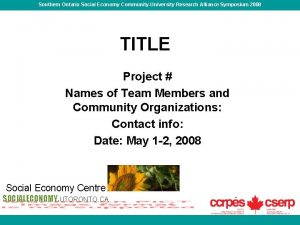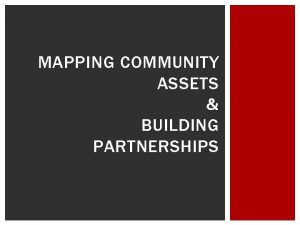Why CommunityUniversity Partnerships Partnerships Enhance quality of life












- Slides: 12

Why Community-University Partnerships? Partnerships Enhance quality of life in the region Increase relevance of academic programs Add public purposes to research agendas Attract new resources Link campus and community in common purpose

University/Community Partnerships Program Modification Summative Assessment Program Closure Institutional Mission and Interests Strategic Planning Community Needs and Assets Partner Needs and Assets Assessment Feedback Loop Program Design Capacity Building Proposal Preparation Funding Secured Project Implementation

Common Partnership Themes Education through the lifespan (technology, literacy, English language, etc. ) School improvement Youth development Community planning and capacity Workforce quality Economic development Health Livability (environment, safety, culture, conflict resolution, etc. )

Characteristics of Effective Partnerships Joint exploration of goals and interests Creation of a mutually rewarding agenda Emphasis on positive consequences for each partner Identification of opportunities for early successes Focus on knowledge exchange, shared learning, and capacity-building Attention to communication, cultivation of trust Commitment to continuous assessment of the partnership itself, as well as outcomes

Sustaining Partnerships Invest the time to build understanding Create formal partnership structures Articulate substantive roles for all partners Meet regularly and often Involve/employ citizens in projects from the start Collaborate in identifying funding Create a timeline; short and long goals Take time to assess and reflect together Celebrate

The Engaged University The engaged institution is committed to direct interaction with external constituencies and communities through the mutually-beneficial exchange, exploration, and application of knowledge, expertise and information. These interactions enrich and expand the learning and discovery functions of the academic institution while also enhancing community capacity. The work of the engaged institution is responsive to community-identified needs, opportunities and goals in ways that are appropriate to the university’s mission and academic strengths. The interaction also builds greater public understanding of the role of the university as a knowledge asset and resource.

Engaged Campus Characteristics Articulates engagement in mission and strategy Involves community in continuous, purposeful and authentic ways Links learning to engagement Links engagement to every aspect of campus org Develops and sustains necessary infrastructure Demonstrates leadership at all levels of organization Supports interdisciplinary work Makes engagement visible internally and externally Assesses engagement within the context of faculty, students, and community

Tools for Institutional Change Mission clarification and consensus Faculty development investments Curricular reform=engaged learning Infrastructure support Incentives, rewards, recognition Orientation, recruitment, hiring Institutional research – documenting impacts Grants, gifts, partnerships Peer interactions, conferences, exchanges

Institutionalization Involvement of campus leadership Investment of campus resources Commitment to evaluate and reward faculty Integration of engagement into curriculum and learning objectives Creation of a coherent engagement agenda Link engagement to teaching and research Collaboration across disciplines and institutions

Validating the Role of Engagement Incorporation of CE into regional accreditation processes Federal investment in grant programs State investment in public service roles Exploration of CE (and learning) as element of Carnegie classifications

Challenges and Needs Dependency on early adopters among faculty; Need to build critical mass Re-design academic work to include community expertise and participation Dependency on external funding; Need to invest institutional assets through integration into operations Lack of a common language that describes/measures CE across institutions Better tools for assessing the quality of this work, its impacts, its effectiveness

Good Ways to Move Ahead Civic engagement must link to what matters to faculty Civic engagement must demonstrably serve institutional goals and ambitions Civic engagement requires a curricular component Civic engagement invites the community into academic work
 Hey bye bye
Hey bye bye Nyjc subject combination
Nyjc subject combination Enhance life
Enhance life Grammar to enrich and enhance writing
Grammar to enrich and enhance writing Define fashion merchandising
Define fashion merchandising Enhance an image
Enhance an image A new backbone that can enhance learning capability of cnn
A new backbone that can enhance learning capability of cnn Cosmetics are substances that are used to enhance
Cosmetics are substances that are used to enhance Enhance an image
Enhance an image Type of salad which stimulate one’s appetite
Type of salad which stimulate one’s appetite Nnn hypno
Nnn hypno Dont ask why why why
Dont ask why why why Accounting for partnerships chapter 12 solutions
Accounting for partnerships chapter 12 solutions

